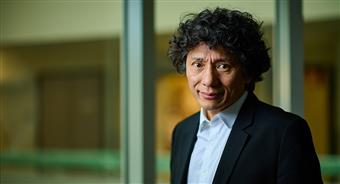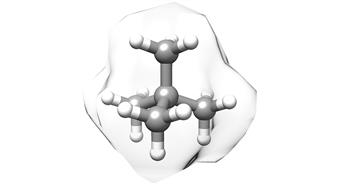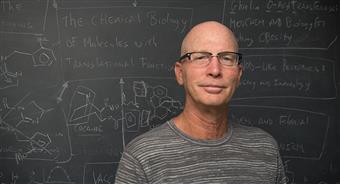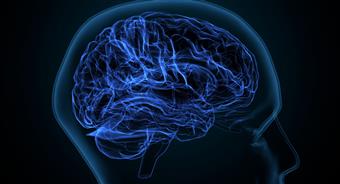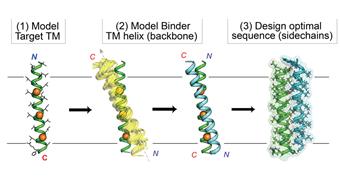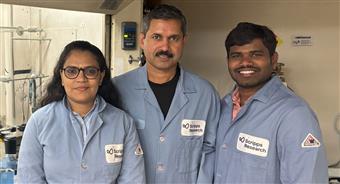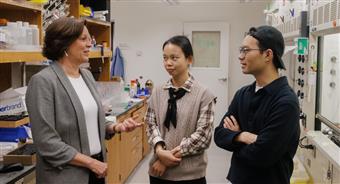
Light after death: scientists revive human eyes By restoring the light-sensing function of human retinas hours after death, Scripps Research and collaborators reveal a new way to study age-related macular degeneration and other eye disorders.
May 11, 2022
LA JOLLA, CA Scientists from Scripps Research and the University of Utah have made the surprising discovery that the human eye can be removed from the body even hours after death and the function of the light-sensing cells in the central vision can be revived.
The finding, reported in Nature on May 11, 2022, enables direct experimentation on the human retina, in a way that had been largely impossible, to better understand eye diseases and develop new ways to treat them. The study also hints that nerve cells from the central nervous system may be easier to revive after death than scientists had widely believed.
We were essentially able to get the cells to wake up' and talk to each other after death, says study co-corresponding author Anne Hanneken, MD, associate professor of Molecular Medicine at Scripps Research, and a long-time retinal surgeon affiliated with Scripps Memorial Hospital La Jolla. We're hoping that this new ability to revive the central human retina and study it directly in the laboratory will lead to a much better understanding of human vision and better care for the millions of patients with retinal diseases.
The scientific community can now study human vision in ways that just aren't possible with laboratory animals, says corresponding author Frans Vinberg, PhD, assistant professor of Ophthalmology & Visual Sciences at the University of Utah's John A. Moran Eye Center, who also holds an appointment as a visiting investigator at Scripps Research. We hope this will motivate scientists to work with organ donor societies and eye banks to build collaborations that will lead to exciting new research discoveries.
The retina is a highly sensitive system that is prone to deterioration due to inherited gene mutations or age-related conditions, including diabetes and age-related macular degeneration. It is estimated that more than 10 million older Americans have retinal degenerative diseases. Current treatments can ameliorate but cannot cure these diseases.
The shortcomings of current treatments are due in part to the obstacles researchers typically face when studying retinal diseases. The retina of the mouse the standard lab animal is quite different from the human retina. Moreover, prior studies from deceased organ donors are scarce. Most researchers believe that human retinal neurons become swiftly non-functional after death.
In the study, researchers confirmed this rapid loss of retinal function in mice, using a method called electroretinography (ERG) to track the decline in retinal neuron activity in the minutes after death. However, they found that if they removed the eyes after death and then restored oxygen and a normal acid-alkaline (pH) balance, the retinas largely revived. There was light-responsive electrical activity in retinal neurons called photoreceptors, and there was evidence of photoreceptor signaling to other retinal neurons, known as bipolar cells and retinal ganglion cells, that constitute the next stage of visual signal processing.
The researchers could revive light-signaling in mouse photoreceptors up to three hours after death. Surprisingly, the scientists found that they could obtain similar retinal signaling from human autopsied eyes when they were removed up to five hours after death.
To enable these experiments, Hanneken collected tissues with the help of the San Diego Eye Bank and the organ donor society Lifesharing and optimized the surgical recovery of the human eyes. Vinberg used his biomedical and electrical engineering background to design a transportation unit to restore the oxygenation of the organ donor eyes and build the ERG device to stimulate and measure the retina.
Overall, researchers say, the experiments generated an unprecedented trove of data on the physiology of human vision. The techniques they developed also offer a new way to study the retina in health and disease and to test drugs, retinal patch transplants, and other strategies against retinal ailments.
One unique aspect of this study was the highly collaborative work from people and organizations that started about five years ago and persisted, says Hanneken. We spent years getting no light signals at all from human eyes. It was perseverance through lots of failures that eventually resulted in this success, which we think will lead to a transformative understanding of human eyesight.
Revival of light signalling in the postmortem mouse and human retina was co-authored by Fatima Abbas, Silke Becker, Bryan Jones and Frans Vinberg of the University of Utah; Ludovic Mure and Satchidananda Panda of the Salk Institute; and Anne Hanneken of Scripps Research.
The research was supported by, among others, the National Institutes of Health (P30 EY014800, UL1 TR002550, EY031706, R01 EY015128, R01 EY028927), the Daro Foundation, the A. C. Israel Foundation, the Warren Family Foundation, the Renaissance Charitable Foundation, The Rancho Santa Fe Foundation, the Money Arenz Foundation, the Considine Foundation, the Fonseca Foundation, the Pfeiffer Foundation, the Mericos Eye Institute, and the Thomas and Audrey Pine Foundation.
Molecular Medicine Hanneken, Anne
More from Scripps
20/04/2024
New copper-catalyzed C-H activation strategy from Scripps Research Two-mode reactions inspired by human detox enzymes offer powerful new tools for drug discover...
12/04/2024
Scripps Research chemists devise easier new method for making a common type of building block for drugs Scientists transform simple linear amines into saturated...
06/04/2024
A simple, inexpensive way to make carbon atoms bind together A Scripps Research team uncovers a cost-effective method for producing quaternary carbon molecules,...
04/04/2024
Developing a vaccine for the zombie drug xylazine Scripps Research chemical biologists design an early proof-of-concept vaccine that could lead to the first...
30/03/2024
How blocking a neural receptor responsible for addiction could reduce alcohol use A Scripps Research team found that a new therapeutic that targets the kappa op...
13/03/2024
New computational strategy boosts the ability of drug designers to target proteins inside the membrane Customized-design approach could streamline the design of...
29/02/2024
Scripps Research scientists reveal how first cells could have formed on Earth New phospholipid discovery brings researchers closer to understanding how primordi...
29/02/2024
How molecular handedness emerged in early biology Scripps Research chemists fill a major gap in origin-of-life theories.
February 28, 2024
LA JOLLA, CA Mole...
22/02/2024
Snaking toward a universal antivenom Scripps Research scientists discovered antibodies that protect against a host of lethal snake venoms.
February 21, 2024
...
06/02/2024
Calibr-Skaggs announces expansion of option and license agreement with AbbVie to develop novel cell therapies for solid tumors and autoimmune diseases
AbbVie...
26/01/2024
Re-energizing mitochondria to treat Alzheimer's disease Scripps Research team restored neuron-to-neuron connections in human cells.
January 25, 2024
LA JO...
24/01/2024
100 years of Science Changing Life: Scripps Research celebrates a century of transforming human health For the last century, institute leaders and renowned scie...
23/01/2024
New technology lets researchers track brain cells' off switches The method could shed light on what goes awry in numerous brain conditions when neurons ar...
09/01/2024
Three decades of giving: Announcing the Calibr-Skaggs Institute for Innovative Medicines The ALSAM Foundation, founded by the Skaggs family, provides lasting g...
04/01/2024
Life science entrepreneur Gene Lay joins Scripps Research Board of Directors Lay, founder of the global biotech company BioLegend, brings invaluable experience ...
21/12/2023
Taming a plant-derived toxin Scripps Research team modifies the traditional poison picrotoxinin for potential neurological drugs and anti-parasite treatments. ...
19/12/2023
Scripps Research Executive Vice President Eric Topol gives TED talk on transformative power of AI in medicine Topol provides an overview of how AI models can i...
13/12/2023
New AI-powered algorithm could better assess people's risk of common heart condition Early detection of atrial fibrillation can reduce the risk of stroke an...
07/12/2023
Nanoparticle flu vaccine design shows promise in early tests Scripps Research-designed vaccine could provide broad, enduring protection against influenza A str...
16/11/2023
Numerous Scripps Research scientists named Highly Cited Researchers Clarivate's annual, global list represents researchers who have demonstrated significant...
07/11/2023
Multiple sclerosis drug invented at Scripps Research slows long-term devastating disease progression Late-breaking data reinforces the effectiveness and safety ...
05/10/2023
Keren Lasker named a 2023 Moore Inventor Fellow The prestigious award will support Lasker's inventive research in membraneless organelles and their applica...
22/09/2023
Michael Bollong named a 2023 Amgen Young Investigator The prestigious award will support Bollong's research identifying new molecular targets and therapeuti...
09/09/2023
Philip Dawson receives 2024 American Chemical Society National Award Dawson is honored with the Arthur C. Cope Late Careers Scholar Award for his foundational c...
07/09/2023
Scripps Research chemists devise a method for C-H activation of alcohols The method represents a new toolkit for making drugs and other compounds.
September 06...
31/08/2023
Scripps Research receives $1.5M to surveil infectious disease threats in wastewater Bill & Melinda Gates Foundation award to support the development of multi-pa...
16/08/2023
How cold temperatures trigger the brain to boost appetite Scripps Research scientists' discovery could lead to new weight loss and metabolic health treatmen...
08/08/2023
Human antibody that targets carfentanil, fentanyl and related opioids reverses overdose effects in preclinical study Scripps Research-developed antibody therapy...
04/08/2023
How sensory neurons impact the gut Scripps Research scientists show that the receptor PIEZO2 in sensory neurons controls gut motility and transit time, which a...
26/07/2023
AbbVie and Calibr Expand Strategic Collaboration to Advance Several Preclinical and Early-stage Clinical Assets The expanded strategic collaboration will advan...
23/07/2023
Scripps Research scientists develop AI-based tracking and early-warning system for viral pandemics Machine-learning system effectively predicts emergence of pro...
19/07/2023
Monitoring T cells may allow prevention of type 1 diabetes Scripps Research study shows that analyzing T cells in blood samples could be used to select at-risk ...
19/07/2023
Scripps Research mourns passing of leading organic chemist Albert Eschenmoser Eschenmoser pioneered key reactions in synthetic chemistry and shaped the understa...
15/06/2023
Scripps Research awarded $46.8 million by NIH to promote human health through innovative translational science and training The Translational Institute is harne...
13/06/2023
Scripps Research's Danielle Grotjahn named 2023 Pew Scholar in the Biomedical Sciences The award will support Grotjahn's study of how cells assemble the...
31/05/2023
Crossing the ring: new method enables C-H activation across saturated carbocycles Scripps Research chemists add another powerful tool to their molecular editin...
24/05/2023
Scripps Research develops behind-the-scenes tool for better biomedical data discovery The new resource makes datasets more discoverable for life science communi...
19/05/2023
Scripps Research neuroscientist Hollis Cline elected to American Academy of Arts and Sciences Cline is recognized for her discoveries about the role of sensory ...
19/05/2023
Scripps Research's Skaggs Graduate School awards doctoral degrees to 31st graduating class Commencement ceremony will be livestreamed via Zoom and on instit...
13/05/2023
A better route to benzocyclobutenes, sought-after building blocks for drugs Scripps Research chemists devise a new, C-H activation-based method for the synthesi...
09/05/2023
Renowned Scripps Research professor Jeffery Kelly elected to National Academy of Sciences Kelly's groundbreaking work on protein misfolding has led to thera...
28/04/2023
Mirror-image molecules pave new path for cancer drug discovery By comparing how mirror image versions of small molecules impact clusters of proteins, Scripps R...
22/04/2023
How alcohol consumption contributes to chronic pain A Scripps Research team showed how both alcohol intake and alcohol withdrawal can lead to increased pain and...
21/04/2023
Xin Jin receives dual awards to study autism risk genes in neurodevelopment Major grants from the National Institutes of Health and California Institute for Reg...
20/04/2023
Trim the sugar: New HIV vaccine design improves immune response Scripps Research vaccine candidate headed for clinical trials.
April 19, 2023
LA JOLLA, CA A...
18/04/2023
Therapeutic can seek and destroy potent opioid to treat overdoses Scripps Research chemists developed a new biologic to work against the synthetic opioid carfen...
07/03/2023
How heavy alcohol consumption increases brain inflammation The findings by a Scripps Research team point toward a potential new drug target for treating alcohol...
02/03/2023
Scientists find human antibodies that can block multiple coronaviruses including SARS-CoV-2 Results from a Scripps Research and UNC team pave the way for a vacc...
28/02/2023
$10 million grant funds Scripps Research Alcohol Research Center through its 50th year The five-year grant supports research into the neurobiology of alcohol us...
28/02/2023
Immune system drug shows promise in treating alcohol use disorder, a Scripps Research clinical trial reports Scientists at Scripps Research found that apremilas...
 Light after death: scientists revive human eyes By restoring the light-sensing function of human retinas hours after death, Scripps Research and collaborators reveal a new way to study age-related macular degeneration and other eye disorders.
Light after death: scientists revive human eyes By restoring the light-sensing function of human retinas hours after death, Scripps Research and collaborators reveal a new way to study age-related macular degeneration and other eye disorders. 














